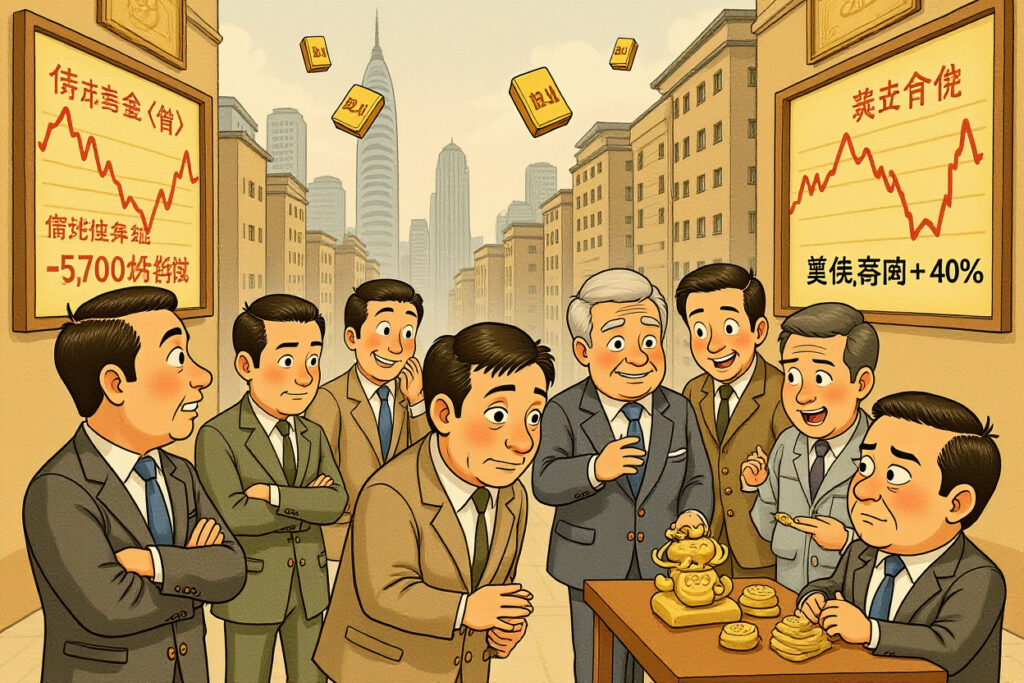Federal Reserve Cuts Rates: Immediate Market Reactions
The U.S. Federal Reserve (美联储) announced its first rate cut of 2025 on September 18, lowering the federal funds target rate by 25 basis points to a range of 4.00% to 4.25%. This decision, following three rate cuts in 2024, triggered significant volatility across global markets, particularly affecting gold prices and equity indices.
Market Volatility Post-Announcement
Following the Fed’s announcement, major U.S. stock indices initially surged before sharply reversing gains. The U.S. dollar index (美元指数) plummeted to a new yearly low before recovering and turning positive. Meanwhile, international gold prices experienced high volatility, briefly breaching the $3,700 per ounce level before retreating below this psychological barrier.
Gold’s Spectacular 40% Year-to-Date Rally
Gold prices have demonstrated extraordinary strength throughout 2025, with spot gold (现货黄金) rising over 40% from its starting point of $2,625 per ounce in January. This represents the most significant surge since 1979, when global energy crises and inflationary pressures drove similar safe-haven demand.
Record Highs and Immediate Pullback
On September 16, COMEX gold futures (纽约黄金期货) reached $3,739.90 per ounce while spot gold touched $3,702.93, setting new historical records. The momentum continued into September 17 with prices climbing to $3,744.00 and $3,707.35 respectively before profit-taking emerged. By the Asian trading session on September 18, spot gold had retreated to $3,658.25 per ounce, representing a modest decline from opening levels but maintaining most of its yearly gains.
Expert Analysis: Short-term Pullback, Long-term Strength
Market experts provide nuanced perspectives on gold’s trajectory following the Fed’s decision, balancing short-term technical factors against longer-term fundamental drivers.
Technical Correction vs. Structural Support
Lin Xianping (林先平), Associate Professor at Zhejiang University City College and Executive Deputy Secretary-General of China Urban Expert Think Tank Committee, notes that rapid gold price appreciation around rate cut expectations often triggers technical corrections. “Markets often ‘buy the rumor, sell the news,’ with some investors taking profits after positive developments materialize,” he explains. “If the rate cut magnitude or forward guidance disappoints expectations, additional price adjustments may occur.” However, he emphasizes that entering a Fed cutting cycle typically provides medium to long-term support for gold prices.
Historical Patterns and Future Projections
Yang Delong (杨德龙), Chief Economist at Qianhai Kaiyuan Fund, observes that Fed rate cuts generally support gold prices over time. “The trend of increasing dollar supply ensures gold’s long-term upward trajectory remains intact,” he states. “Reaching $5,000 or even $10,000 per ounce is merely a matter of time.” Bai Wenxi (柏文喜), Deputy Director of the China Enterprise Capital Alliance, adds historical context: “During periods when inflation remains above 2% while the Fed cuts rates, gold has never declined over the subsequent year, delivering average annualized returns of approximately 13%.”
Institutional Forecasts: Bullish Price Targets
Major financial institutions have revised their gold price targets upward, reflecting confidence in the metal’s continued appreciation despite recent volatility.
Goldman Sachs and Morgan Stanley Outlook
Goldman Sachs projects gold reaching $4,000 per ounce by mid-2026 under baseline conditions, with tail-risk scenarios pushing prices toward $4,500. In extreme circumstances where just 1% of privately held U.S. Treasury funds flow into gold, prices could approach $5,000 per ounce. Morgan Stanley has set a fourth-quarter 2025 target of $3,800 per ounce, emphasizing the ongoing negative correlation between gold prices and the U.S. dollar index as the key pricing dynamic.
Chinese Market Implications: Retail and Banking Sector Adjustments
The gold price surge has significantly impacted Chinese retail markets and financial institutions, prompting adjustments to product offerings and risk management measures.
Retail Gold Price Movements
Domestic gold jewelry brands have consistently raised prices throughout September. Chow Sang Sang (周生生) reached 1,091 yuan per gram on September 16, representing a 17-yuan increase from the previous day. Other major brands including Lao Feng Xiang (老凤祥), Chow Tai Fook (周大福), Luk Fook Jewelry (六福珠宝), Chow Tai Seng (周大生), and Lao Miao Gold (老庙黄金) traded between 1,086 and 1,087 yuan per gram. By September 18, some moderation appeared with Chow Tai Fook at 1,078 yuan and Saturday Gold (周六福) at 1,038 yuan per gram.
Banking Sector Risk Management
Multiple banks have adjusted precious metals business parameters to manage increased volatility. On September 3, the Shanghai Gold Exchange (上海黄金交易所) announced adjustments to margin requirements and daily price limits for gold and silver deferred contracts, simultaneously issuing risk warnings. The following day, Bank of China (中国银行) adjusted margin ratios and price limits for individual Shanghai Gold Exchange代理 business, while Agricultural Bank of China (农业银行) modified price limits for its Gold Market Access business.
Investment Implications and Strategic Considerations
For investors navigating current market conditions, several key considerations emerge from the recent price action and expert commentary.
Short-term Caution, Long-term Opportunity
Bai Wenxi emphasizes that provided the Fed confirms “a cutting cycle has just begun” rather than implementing a one-time adjustment, significant downside remains limited. “Historically, noticeable gold price declines occur approximately one month after rate cuts, typically remaining below 5%,” he notes. “While chasing prices higher requires caution, any retreat toward $3,600 or below presents布局 opportunities from both technical and medium-term fundamental perspectives.”
Portfolio Allocation Strategies
Given gold’s demonstrated ability to preserve value during monetary easing cycles, institutional investors should consider strategic allocations despite recent volatility. The metal’s negative correlation with traditional assets during periods of dollar weakness provides valuable diversification benefits that justify inclusion in balanced portfolios.
Navigating Gold’s New Paradigm
The Fed’s September rate cut has introduced renewed volatility into gold markets, triggering a expected technical correction following extraordinary yearly gains. While short-term price movements may reflect profit-taking and position adjustment, the fundamental case for gold remains compelling amid ongoing monetary easing and structural dollar concerns. Investors should view any meaningful price retreat as potential accumulation opportunities within a broader upward trend that institutions project will continue through 2026. Monitor upcoming Fed communications for confirmation of a sustained cutting cycle, which would provide additional support for gold’s next advance toward institutional price targets.
For ongoing coverage of gold market developments and Fed policy impacts, subscribe to our institutional research updates or consult with our dedicated metals strategy team.




